Building Blocks, Literally
Perhaps alphabet blocks seem like an obvious idea now, but it took a lot of foundation to build up that pretty good idea into something incredibly common.
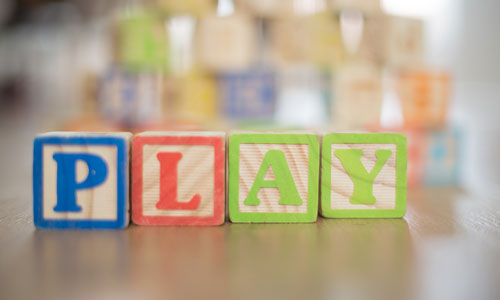
“A ready way for children to learn their A.B.C.”: The guy who likely invented the alphabet block doesn’t get enough credit
The evolution of wooden alphabet blocks shares a lineage with dice, which are similarly cube-shaped, and similarly convey different kinds of information on each side.
Dice, of course, are one of the oldest forms of gaming on the planet, with roots in ancient Egypt and ancient Greece, along with associations with the earliest board games, which date back to 5000 B.C.—which is a very long time.
Alphabet blocks, on the other hand, are a somewhat more recent invention, with dice providing a clear point of inspiration for the blocks, which were generally first conceptualized in 16th and 17th centuries. English philosopher John Locke is closely associated with the wooden block, based on his 1693 work Some Thoughts Concerning Education, which briefly makes mention of the general concept behind alphabet blocks.
“There may be dice, and play-things, with the letters on them to teach children the alphabet by playing; and twenty other ways may be found, suitable to their particular tempers, to make this kind of learning a sport to them,” he was quoted as saying in the work.
Locke, however, was not the first person to make the case for blocks to be used in this way—if anything, in fact, he simply popularized them. The person who perhaps deserves credit for formulating the concept was Sir Hugh Plat, the English writer who wrote of the idea in a 1594 book of inventions titled The Jewell House of Art and Nature.
The book, which can be read in full over this way, discusses “Divers Rare and Profitable Inventions, together with sundry new Experiments in the Art of Husbandry,” gathered from the “Authours own experience.” (I’m sticking to Plat’s own writing as much as possible, for full effect.)
The book is full of interesting inventions and discoveries by Plat, including a form of portable ink designed to be carried around in a powder form, a ready way to catch pigeons, a way to defend a horse from flies, a cheap way to build a wooden bridge, and numerous other ideas gathered by Plat.
It also, most interestingly, includes an illustrated example of what alphabet blocks should look like, along with a basic description of their use case and their point of inspiration.
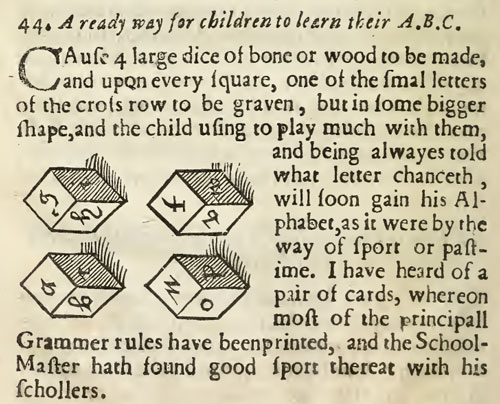
In case you don't want to struggle with reading this, I basically rewrote this directly below. (Internet Archive)
“Cause 4 large dice of bone or wood to be made, and upon every square, one of the small letters of the cross row to be graven, but in some bigger shape, and the child using to play much with them, and being always told what letter chanceth, will soon gain his Alphabet, as it were by the way of sport and pastime,” Plat wrote.
He added that the idea was also inspired by early teaching techniques.
“I have heard of a pair of cards whereon most of the principal Grammer rules have been printed, and the School-Master hath found good sport thereat with his schollers,” he explained.
Plat is perhaps better known for some of his other works, including his gardening book Floreas Paradise, from 1608, and his recipe book Delights for Ladies, from 1602.
But his block idea deserves some respect! Plat was ahead of the curve on this concept in the Elizabethan era, and he hasn’t received very much of the credit into the modern day. In fact, one of the few to give Prat credit for his work throughout history is the 19th century historian Alice Morse Earle, who wrote of Locke’s influence on the alphabet block in her book Child Life in Colonial Days, but properly gave Prat his credit for the idea.
Earle explained, while quoting a series of letters, how General Charles Cotesworth Pinckney, later a military leader in the Revolutionary War, learned the alphabet as a result of the wooden blocks he was given.
“He will soon be the best scholar, for he can tell his letters in any books without hesitation, and begins to spell before he is two years old,” Pinckney’s mother, Eliza, wrote in a letter to her sister.
The blocks apparently did the trick.
“The blocks being thus constructed, and reference being had to the numerals placed thereon and the printed key, it will be found that words can be readily spelled by combining the requisite number of blocks and those words in which the same letter occurs more than once, which was not possible with the style of blocks now in use.”
— Samuel L. Hill, writing in his 1867 patent for the alphabet block about its benefits from a spelling standpoint. The advantage that Hill’s Brooklyn company had was manufacturing—Hill’s Spelling Blocks were the first mass-produced spelling blocks, and the set of 20 cube blocks was actually enough to actually spell some fairly lengthy words (as long as you had the right letters).
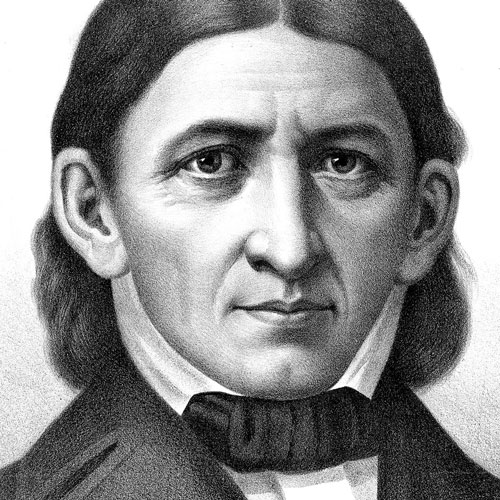
Friedrich Fröbel (Wikimedia Commons)
The guy who invented the word “Kindergarten” also ensured toy blocks would always have a place in the toy aisle
The German educator Friedrich Wilhelm August Fröbel casts a long shadow on the concept of modern education, in more ways than one.
Spending much of his career focused on issues of learning, he spent an earlier part of his career publishing a series of important works on education, most notably the book Die Menschenerziehung, or The Education of Man, an 1826 tome that was considered Fröbel’s chief literary output.
But it was what Fröbel did in the final years of his life that truly left a mark on the world. He rededicated himself to hands-on education, focusing on young children, and in 1837, opened an activity-driven institute for children in the village of Bad Blankenburg.
By 1840, he had changed the name of the institute to Kindergarten (or "children's garden"), an institute in which he perfected his early-childhood education techniques, which focused on the concepts of activity-driven play to the learning process. He wasn’t the first person to think in this direction, but he was perhaps the most influential.
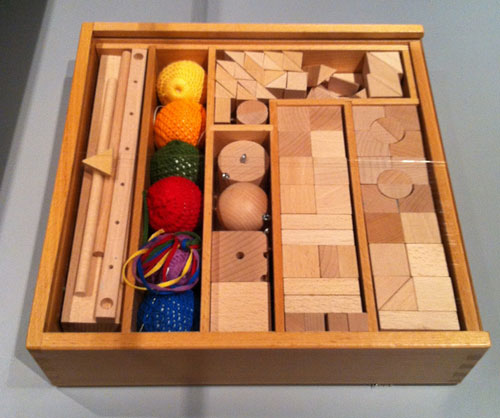
Fröbel's gifts, shoved in a box, which is not their natural habitat. (Wikimedia Commons)
To help with this, Fröbel designed a series of educational toys he called “gifts,” a series of ever-more-complex materials designed to spark creativity among children. (They’re still sold today, though just a warning that they’re quite expensive.)
“They are a coherent system, starting at each stage from the simplest activity and progressing to the most diverse and complex manifestations of it,” Fröbel explained in his writings. “The purpose of each one of them is to instruct human beings so that they may progress as individuals and members of humanity is all its various relationships.”
Many of Fröbel’s gifts took the form of square or rectangular blocks that worked together in a complex system, introducing forms of spatial play over time. It’s not hard to see the concepts of the modern toy industry in the gifts that Fröbel created.
(Nor is it hard to see how this might inspire some of our greatest architectural thinkers. Frank Lloyd Wright, famously, claimed inspiration from Fröbel’s gifts.)
But while Fröbel set the groundwork and his Kindergarten idea started to catch on globally not long after his 1852 passing, it was an American lithographer and board game manufacturer who would help carry the torch in the United States. That man’s name was Milton Bradley.
In 1870, Bradley’s namesake company came out with a set of building blocks based on Fröbel’s work called Bradley’s Original Kindergarten Alphabet and Building Blocks. The blocks were based on Fröbel’s sixth gift, which included a variety of basic geometric shapes. Bradley, however, added the additional wrinkle of letters and numbers.
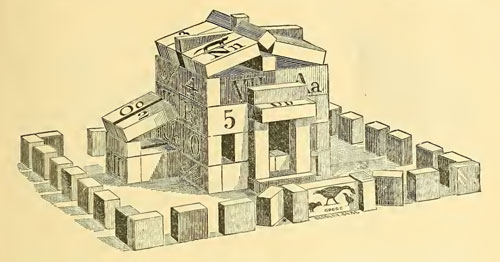
Bradley’s Original Kindergarten Alphabet and Building Blocks. This is the early education version of dogs and cats living together. (Internet Archive)
The 1996 book Preschool Education in America: The Culture of Young Children from the Colonial Era to the Present suggests that Bradley’s play was purely commercial, but offered up something of a happy accident in the process.
“What probably seemed like an insignificant alteration to Bradley radically changed the purpose of the blocks, turning them into a didactic teaching device rather than a symbolic play material,” author Barbara Beatty explained.
Beatty noted that the growth of early education, a space inspired by Fröbel’s work, had created a quickly expanding commercial toy industry, and that industry didn’t necessarily understand the educational fundamentals of the educators that made the space viable.
“Toy manufacturers were usually more interested in selling their wares than in observing the finer points of pedagogical correctness,” she noted.
Perhaps, but they nonetheless played an important role in mainstreaming Fröbel’s ideas.
1882
The year that author Adeline Dutton Train Whitney patented an early alphabet block system. Whitney has been credited in a few places as the inventor of cube-shaped alphabet blocks, but that’s inaccurate, alas. Instead, her blocks were something of an elaborate evolution on the ideas of Fröbel, Locke, Hill, and Plat. Made up of various shapes and sizes, the blocks make it possible to create “the different letters of the alphabet, the various numerals, and other figures or characters commonly used in print in regular proportion and on a uniform scale,” according to her patent from the era. Whitney’s creation is still great and highly educational—it’s just not the alphabet block that we know and love. (Whitney, by the way, is also known for the book Mother Goose for Grown Folks.)
If there’s a lesson to be taken from this—besides the ABC’s, of course—it’s that it’s hard to figure out who was first with an idea or an invention, and who’s getting the right amount of credit.
References to Plat’s role in the alphabet block are rare; references to Locke’s role are common. (And, to be fair, it’s always possible Plat might have been inspired by someone else. The sands of history get a little thin after a while.) But without one influencing the other in some cosmic way, it’s perhaps hard to see how we would have ended up with this very common object in the form we got it.
It shows how these ideas build on one another. When someone has an idea as seemingly basic as putting a bunch of letters on a block of wood, or making a die large enough so that it’s the perfect size for a child to hold, or philosophically making the case for the use of such an object by children, these ideas add onto one another and turn a small idea into a much larger one.
And those ideas inspire other ideas, too: Little Folks Cubes, a 19th-century cube set, used illustrations instead of letters, allowing the cubes to tell a story. Sometimes cubes inspire crafting projects or miles of Pinterest pages highlighting baby names. And you could probably make the argument that the Rubik’s Cube borrowed some base influence from the way that the letters and numbers combined.
The figures I mention above each played their own role through in turning this idea into something obvious, an education tool used the world over.
Or to put it in a punnier way: A lot of building blocks were involved.
:format(jpeg)/2017/05/tedium051617.gif)
/2017/05/tedium051617.gif)

/uploads/ernie_crop.jpg)